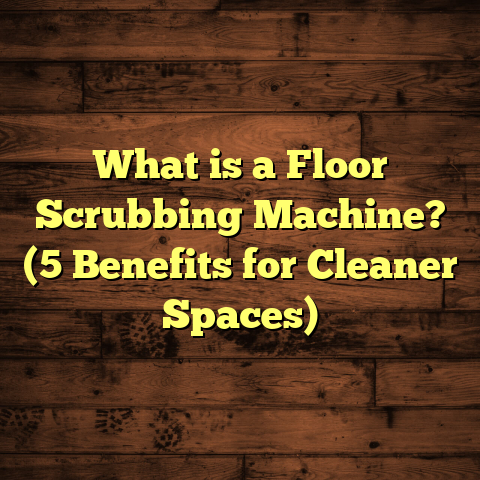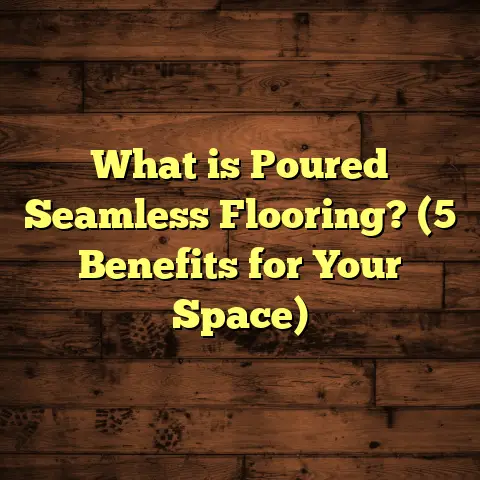What is a Floor Cleanout? (5 Essential Facts for Maintenance)
Investing in your home’s flooring might seem straightforward—pick a style, buy the materials, and get it installed. But there’s an often overlooked part of the process that can save you time, money, and a lot of headaches down the road: the floor cleanout. When I first started working in flooring, I didn’t pay much attention to it either. However, after several projects where hidden debris caused delays and damage, I quickly realized how critical a cleanout is.
Let me walk you through what a floor cleanout really is, why it’s important, and how it fits into the bigger picture of maintaining and protecting your investment.
What is a Floor Cleanout?
At its core, a floor cleanout is the process of thoroughly cleaning the subfloor and surrounding areas before installing or repairing flooring. This includes removing dust, debris, old adhesive residues, nails, and any other materials that could interfere with the new flooring.
But it’s not just about sweeping or vacuuming. A proper floor cleanout often involves more detailed steps like:
- Scraping off old glue or mortar
- Patching cracks and holes
- Checking for moisture issues
- Ensuring the subfloor is level and smooth
Think of it as preparing the foundation for your flooring to perform at its best. I always say you can’t expect a carpet or hardwood to look good or last if the surface underneath isn’t ready.
The Difference Between Floor Cleanout and Regular Cleaning
You might ask: isn’t cleaning the floor before installation just regular sweeping or mopping? Not quite. Regular cleaning is surface-level—dusting or vacuuming the top layer. Floor cleanout digs deeper.
For example, when installing hardwood over plywood, leftover paint chips or drywall dust can prevent adhesives from bonding properly. Similarly, concrete slabs need to be free from curing compounds or laitance (a weak surface layer). These details matter because they affect how well your flooring adheres and performs.
Why Does Floor Cleanout Matter?
You might wonder, “Why fuss over this if I’m just covering it up?” Well, here’s what I’ve learned over the years:
Avoiding Installation Problems
When I skipped thorough cleanouts early on, I encountered warped planks, loose tiles, and bubbling vinyl. That’s because leftover debris or moisture can prevent adhesives from bonding properly or cause uneven settling.
Data from several flooring industry studies show that about 30% of installation failures trace back to poor surface preparation. That’s a huge chunk!
For instance, the National Wood Flooring Association (NWFA) highlights that improper subfloor prep leads to 40% of wood flooring issues reported within the first year of installation.
Extending Flooring Life
A clean subfloor helps prevent premature wear and tear. Moisture trapped under flooring can lead to mold growth or rot, especially with wood products. In one project I handled, a missed moisture issue caused costly repairs just six months after installation.
Moisture-related damages contribute to roughly 25% of all flooring failures in residential settings according to home maintenance surveys.
Saving Money Long-Term
Although cleanouts add upfront time and effort, they reduce callbacks and repairs. According to a home improvement report by Remodeling Magazine, homeowners save an average of 15% on flooring maintenance costs over five years when proper subfloor prep is done.
In my experience, spending an extra day prepping saved my clients thousands in future repairs.
The Essential Steps in Floor Cleanout
I’ve developed a checklist that helps me tackle every job efficiently:
1. Inspection
Start by examining the area for nails, staples, or loose boards. Look for water stains or warping. Early detection of problems can save major headaches later. For example, catching a small water stain might indicate an unseen leak.
2. Removal
Pull up old flooring remnants like carpet padding or tile mastic. Use scrapers and vacuums to clear dust. When I worked on a commercial project once, ignoring old adhesive left behind caused new vinyl tiles to buckle within weeks.
3. Repair
Fill cracks with appropriate fillers and replace damaged sections. Using high-quality patching materials compatible with your flooring type is key here.
4. Leveling
Use a leveling compound where needed to create an even surface. Uneven floors cause squeaks, gaps, and uneven wear on your finished floor. I’ve seen cases where floors were off by as much as 3/8 inch over a few feet — way beyond acceptable tolerances.
5. Moisture Testing
This step is often skipped but critical—especially on concrete slabs. I rely on moisture meters for accurate readings. There are two common methods: calcium chloride tests (for concrete) and relative humidity testing inside slabs.
In one job, moisture testing prevented us from installing hardwood too soon after slab curing — which would have led to warping and cupping.
Diving Deeper into Moisture Issues
Moisture is one of the biggest enemies of flooring installations. Even if your surface looks dry on top, moisture can reside under concrete slabs or trapped in subfloor layers.
Why Moisture Matters
Moisture causes expansion and contraction cycles in wood floors that lead to gaps or buckling. It also promotes mold growth that damages both floors and indoor air quality.
How to Test for Moisture
- Pin-type meters: Measure electrical resistance through wood but less effective on concrete.
- Pinless meters: Use electromagnetic signals and are non-destructive.
- Calcium chloride tests: Measure moisture vapor emission rates from concrete.
- Relative humidity probes: Inserted into drilled holes in concrete slabs for precise readings.
I always recommend at least two tests before proceeding with wood or laminate installations over concrete.
Personal Experience: How Cleanouts Saved My Project
One project stands out where a quick floor cleanout made all the difference. The client wanted new hardwood installed over an old plywood subfloor. Initially, the site looked clean enough.
But a closer look revealed tiny bits of drywall dust and some leftover paint chips embedded in the surface. We took the time to sand and vacuum everything thoroughly.
During moisture testing, we found slight dampness from a previous leak that wasn’t repaired yet. We delayed installation until after fixing it.
Result? The hardwood went down flawlessly with zero issues for years after. This was a win that taught me never to rush the prep.
Another time I worked on a rental property where previous tenants had spilled paint that seeped into cracks between boards. Because we identified this during cleanout and used proper cleaners and sanding, we avoided adhesive failure when laying vinyl planks.
Common Challenges in Floor Cleanouts
Here are some obstacles I’ve seen contractors and DIYers face:
- Hidden debris: Nails or screws left in subfloors can damage tools or cause unevenness.
- Moisture surprises: Concrete slabs especially hold moisture longer than expected.
- Time crunches: Skipping cleanouts to save time often backfires with costly fixes later.
- Waste management: Removing old materials can create disposal challenges.
- Uneven surfaces: Older homes often have uneven or warped subfloors requiring extensive leveling.
- Adhesive residues: Old glue spots can prevent new adhesives from sticking properly.
- Dust control: Fine dust from sanding creates health hazards without proper ventilation or protection.
If you’re tackling this yourself, prepare accordingly so you’re not caught off guard.
Tools and Techniques for Effective Floor Cleanouts
When cleaning out a floor before installation, having the right tools makes all the difference:
Scrapers and Grinders
For removing old adhesives or leveling rough patches. I prefer diamond grinders for concrete surfaces because they’re efficient but also controlled enough not to damage slabs.
Industrial Vacuums
Dust control is critical. A vacuum with HEPA filters helps trap fine particles instead of spreading them around.
Moisture Meters
Investing in reliable meters pays off by preventing moisture-related failures.
Personal Protective Equipment (PPE)
Dust masks, goggles, gloves—they’re not just for show but protect your health during sanding and scraping.
Leveling Compounds
Self-leveling compounds help create smooth surfaces quickly but require proper mixing and curing times to work well.
How Tools Like FloorTally Help Me Manage Flooring Costs
Managing budgets on flooring projects has always been tricky, especially when factoring in prep work like cleanouts—which sometimes requires extra materials or labor.
I use FloorTally to estimate costs based on local rates for materials and labor. What I appreciate is how it includes waste factors automatically so I don’t underestimate what I’ll need for repairs or leveling compounds during cleanouts.
This tool saves me from getting multiple quotes and keeps my budgeting realistic without surprises. It’s like having a reliable assistant helping with calculations so I can focus on the hands-on stuff.
For example, on one recent two-bedroom remodel, FloorTally helped me calculate not only the cost of hardwood planks but also associated labor hours for prep work including cleanouts and patching cracks—saving me nearly 10 hours of guesswork.
Understanding Subfloor Types and Their Impact on Cleanouts
Different subfloor materials require different approaches:
Plywood & OSB
Common in wood-frame homes. They’re prone to swelling if exposed to moisture but are easier to patch than concrete. Nails sticking out are a common problem here.
Concrete Slabs
More durable but can hold moisture longer and develop cracks that need filling. Surface contaminants like curing compounds must be removed for proper bonding.
Existing Tile Floors
Sometimes floors are installed over old tile which must be cleaned or leveled before new flooring goes down. Removing tile is expensive so cleaning off adhesive residues becomes crucial.
I always tailor my cleanout approach based on these materials for best results.
The Role of Waste Management in Floor Cleanouts
Removing old flooring materials creates waste that must be handled responsibly.
I remember one job where we had leftover asbestos-containing floor tiles—a serious health hazard requiring professional removal services.
Even with regular materials, disposing of large volumes of old carpet padding or tile scrap involves knowing local regulations about construction waste disposal.
Planning waste management early avoids delays mid-project and keeps job sites safe and organized.
Case Study: Flooring Longevity Linked to Clean Subfloors
I worked with a property management company overseeing multiple apartment units. They had recurring complaints about carpet damage and tile cracking only a year post-installation.
After investigating, we discovered inconsistent floor prep was common—some units got thorough cleanouts; others barely any.
We standardized procedures across all units and mandated moisture tests before installation. Within two years tenant complaints dropped by 60%, and flooring replacements became far less frequent.
This case reinforced that consistent prep practices don’t just improve aesthetics but directly impact durability and tenant satisfaction—both critical for property managers aiming to reduce turnover costs.
How Weather and Climate Affect Floor Cleanouts
I live in an area with high humidity summers and cold winters—this affects how floors behave underneath surfaces year-round.
In humid climates:
- Subfloors absorb moisture more easily.
- Concrete takes longer to dry after rain or snow melt.
- Mold risk increases under carpets if ventilation is poor.
In cold climates:
- Expansion/contraction cycles are more extreme.
- Subfloor movement may cause squeaks if not properly secured.
- Freeze-thaw cycles can create cracks in concrete slabs needing patching during prep.
Knowing how local weather impacts your flooring helps you plan timing for installations and prep work wisely so you don’t install floors over damp surfaces or in unsuitable conditions.
Maintenance Tips After Installation: Keeping Floors Clean From Below
Once you take care of your floor cleanout during installation, maintenance isn’t just about sweeping the top layer.
Here are some things I recommend:
- Maintain consistent indoor humidity levels (ideally 35–55%) using dehumidifiers or humidifiers.
- Avoid wet mopping wood floors; use damp cloths instead.
- Check under rugs periodically for trapped moisture.
- If you hear creaks or feel unevenness developing over time, consider inspecting subfloors professionally.
- For tiled floors with grout lines, reseal grout every few years to prevent water intrusion below tiles.
- Use furniture pads to avoid dents that can affect subfloor integrity eventually.
Taking these steps prolongs the excellent foundation you established with your initial floor cleanout process.
Comparing DIY Versus Professional Floor Cleanouts
Many homeowners ask if they can handle floor cleanouts themselves versus hiring pros like me.
Here’s my take:
DIY Pros
- Saves money upfront
- Gives you control over timing
- Good for small projects or simple floors
DIY Cons
- Risk missing hidden issues like moisture or structural damage
- Requires tools you may not own (moisture meters, grinders)
- Time-consuming if unfamiliar with best practices
Professional Pros
- Experience spotting potential problems early
- Access to specialized tools & safety equipment
- Faster prep freeing you up for other tasks
Professional Cons
- Higher upfront cost
- Scheduling required
For big projects or when you want peace of mind about longevity, hiring pros pays off handsomely by avoiding costly mistakes later on. For smaller rooms or rentals where budget is tight, DIY can work if you commit to learning prep techniques thoroughly.
Environmental Considerations During Floor Cleanouts
Sustainability matters more than ever now when renovating homes:
- Use eco-friendly solvents when removing adhesives instead of harsh chemicals.
- Recycle old tiles or wood when possible rather than sending them all to landfills.
- Choose low-VOC patching compounds to reduce indoor air pollution.
- Dispose of hazardous materials like asbestos-containing tiles through certified services only.
In my projects, clients appreciate knowing their flooring upgrades not only look great but also minimize environmental impact during prep stages too.
Final Thoughts From My Experience
Taking time for a proper floor cleanout isn’t glamorous but it’s one of those behind-the-scenes tasks that pay dividends later on.
Have you ever had a flooring project go sideways because of something hidden beneath? If so, you’re not alone — many homeowners overlook this until problems arise.
By sharing my experiences and insights here, my hope is you’ll feel better equipped to handle your next flooring job without surprises.
If you want help estimating costs or figuring out material needs during your prep work, tools like FloorTally have been a solid resource for me in balancing precision with convenience.
Remember: a solid foundation makes for beautiful floors that last years.
If you want me to share tips on specific floor types or installation techniques next, just ask!





